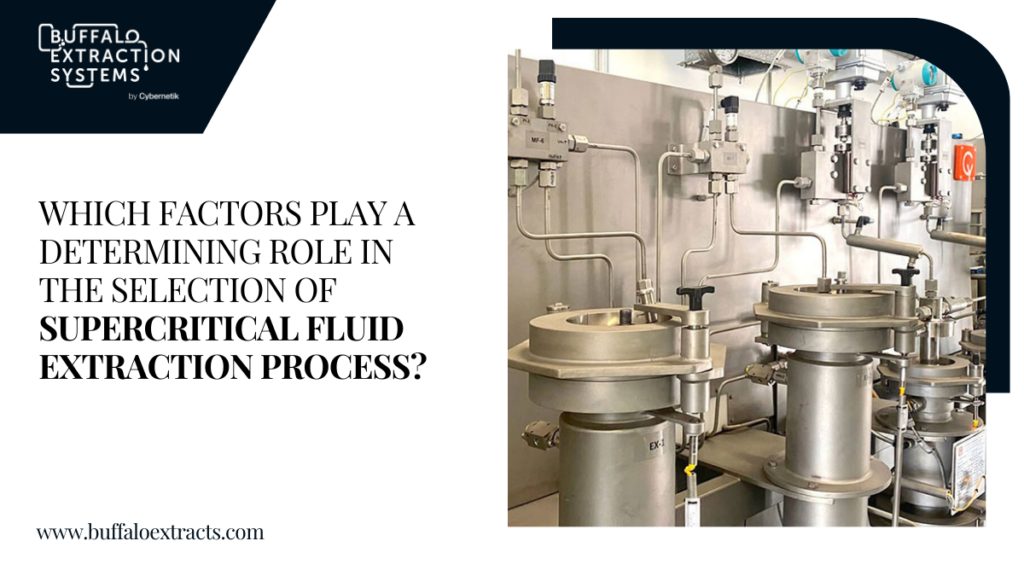Mastering the Selection of Supercritical Fluid Extraction Process for Optimal Results
Industries are increasingly seeking eco-friendly and efficient extraction processes as sustainability and environmental consciousness assume greater and greater importance. Among these, supercritical fluid extraction (SCFE) has emerged as a game-changer, offering a green and versatile solution for extracting valuable compounds from various raw materials. The selection of the supercritical fluid extraction process is a critical decision that can significantly impact the extracted products’ quality, yield, and purity. We will delve into some of the key factors that govern the selection of the supercritical fluid extraction process, ensuring optimal outcomes across diverse industries.
Understanding Supercritical Fluid Extraction (SCFE)
Supercritical fluid extraction is a cutting-edge technology that harnesses the unique properties of supercritical fluids, which exhibit characteristics between those of a liquid and a gas. These fluids possess exceptional solvating power, low viscosity, and high diffusivity, making them ideal for selective and efficient supercritical CO2 extraction process. Carbon dioxide (CO2) is the most commonly used supercritical fluid due to its relatively low critical temperature and pressure, non-toxicity, and inert nature.
Now, the supercritical state is achieved when a substance is heated and pressurized beyond its critical point, where the distinct liquid and gas phases merge into a single homogeneous phase. In this state, supercritical fluids exhibit liquid-like densities and gas-like transport properties. Supercritical fluids can penetrate solid matrices with ease and selectively solubilize and extract target compounds.
The unique properties of supercritical fluids, particularly CO2, make them highly advantageous for extraction processes across various industries. Their exceptional solvating power allows for the efficient extraction of a wide range of compounds, from non-polar to moderately polar substances. The low viscosity and high diffusivity of supercritical fluids facilitate rapid mass transfer and enhance extraction efficiency. Higher yields and purity of products are achieved because of the low viscosity and high diffusivity of the supercritical fluids.
Moreover, the relatively low critical temperature and pressure of CO2 make the application of supercritical fluid extraction suitable for extracting thermally sensitive compounds without degradation. This is a crucial factor in industries such as pharmaceuticals, nutraceuticals, and natural product extraction. The non-toxic and inert nature of CO2 also contributes to the environmental friendliness and safety of the supercritical fluid extraction process. This aligns with the growing demand for sustainable and eco-friendly manufacturing practices.
Factors Influencing the Selection of Supercritical Fluid Extraction Process
The selection of the supercritical fluid extraction process is governed by several critical factors that must be carefully considered to achieve the desired results. These factors include:
- Selective Extraction of Desired Compounds: The supercritical fluid extraction process offers remarkable selectivity, enabling the targeted extraction of specific compounds based on their solubility in the supercritical fluid. By carefully adjusting parameters such as pressure, temperature, and the use of co-solvents, the process can be fine-tuned to selectively extract the desired compounds while minimizing the extraction of unwanted components.
- Thermal Stability of Target Compounds: One of the key advantages of the supercritical fluid extraction process is its ability to extract thermally sensitive compounds without degradation. This is particularly important in industries such as pharmaceuticals, nutraceuticals, and natural product extraction, where heat-sensitive compounds are often involved. By operating at relatively low temperatures, the SCFE process preserves the integrity and bioactivity of these delicate molecules.
- Yield and Purity of Extracts: The selection of the supercritical fluid extraction process is often driven by the need for higher yields and purity of extracts. Compared to conventional extraction methods, SCFE typically results in higher extraction efficiencies and purer extracts, free from residual solvents or contaminants. This is particularly crucial in industries such as food, pharmaceuticals, and cosmetics, where product quality and safety are of utmost importance.
- Scalability: Supercritical fluid extraction (SCFE) can be scaled from small- to large- scale production while maintaining consistent performance and product quality. The inherent nature of supercritical fluids and the modular nature of SCFE systems facilitate efficient upscaling by increasing equipment capacity. Such scalability enables industries to meet growing demands for high-quality extracts and specialized compounds. SCFE can be scaled without compromising efficiency or product quality.
- Environmental Impact and Toxicity: As environmental concerns continue to shape industry practices, the selection of the supercritical fluid extraction process is influenced by its eco-friendly and non-toxic nature. Carbon dioxide, the most widely used supercritical fluid, is readily available, non-flammable, and can be easily separated from the extracts, minimizing waste and environmental impact. SCFE systems recirculate CO2 which prevents it from acting like a greenhouse gas (GHG).
- Compatibility with Complex Raw Materials: The supercritical fluid extraction process is highly versatile and can be applied to a wide range of matrices, including plant materials, algae, and natural products. Its ability to penetrate complex matrices and selectively extract target compounds makes it an attractive choice for industries dealing with intricate raw materials.
- Customizable Solvent Power: One of the remarkable advantages of the supercritical fluid extraction process is the ability to customize the solvent power by adjusting pressure and temperature. This flexibility allows for the optimization of extraction conditions to suit specific target compounds, ensuring maximum efficiency and selectivity.
Finally
Selection of the supercritical fluid extraction process is crucial for optimal results across industries. Industries can harness this technology’s full potential by considering factors such as thermal stability, selectivity, yield, purity, environmental impact, and compatibility with complex matrices. The ability to customize solvent power by adjusting pressure and temperature enhances versatility and fine-tuning for specific compounds and requirements.
As research continues for refining and optimizing the supercritical fluid extraction process, its applications are expected to expand, driving innovation and sustainability in diverse sectors. From food and beverage to pharmaceuticals, nutraceuticals, cosmetics, environmental, and analytical applications, this process proves invaluable. As industries embrace sustainable and efficient extraction technologies, the supercritical fluid extraction process holds immense potential for unlocking new frontiers.

